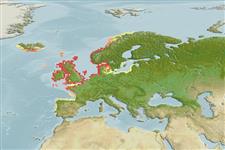Common names from other countries
Environment: milieu / climate zone / depth range / distribution range
Ecologia
marinhas demersal; oceanódromo (Ref. 51243); intervalo de profundidade 17 - 22 m (Ref. 57178). Temperate; 72°N - 38°N, 25°W - 22°E
Northeast Atlantic: Lisbon north to Finnmark, around the British Isles, in the Skagerrak and Kattegat and Iceland.
Tamanho / Peso / Idade
Maturity: Lm ? range ? - ? cm
Max length : 25.0 cm TL macho/indeterminado; (Ref. 1371); common length : 17.0 cm TL macho/indeterminado; (Ref. 1371); common length :20 cm TL (female); Idade máx. registada: 3.00 anos (Ref. 1371)
Espinhos dorsais (total): 0; Espinhos anais 0. Head relatively small, more than five times in SL. No lobed fold of skin above the upper lip. First fin ray followed by a row of small, fleshy filaments. Dark brown dorsally, reddish to blackish grading to pale gray-brown ventrally (Ref. 1371). One barbel on the lower jaw and four on the snout (Ref. 35388).
A resident intertidal species with homing behavior (Ref. 32612). Generally close to the shore, not descending to great depths beyond the limits of the distribution of green algae (20 m), preferring rock bottoms but also living on sandy, muddy, and shell gravel bottoms. Feed mainly on crustaceans, sometimes also on algae, polychaetes, gastropods and occasionally, small fish. Occurs in temperatures ranging from 8 to 24°C (Ref. 4944).
Eggs and larvae are pelagic.
Cohen, D.M., T. Inada, T. Iwamoto and N. Scialabba, 1990. FAO species catalogue. Vol. 10. Gadiform fishes of the world (Order Gadiformes). An annotated and illustrated catalogue of cods, hakes, grenadiers and other gadiform fishes known to date. FAO Fish. Synop. 125(10). Rome: FAO. 442 p. (Ref. 1371)
Categoria na Lista Vermelha da IUCN (Ref. 130435)
CITES (Ref. 128078)
Not Evaluated
Ameaça para o homem
Harmless
Utilização humana
Pescarias: espécies comerciais
Mais informação
ReferênciasAquaculturaPerfil para aquaculturaEstirpesGenéticaElectrophoresesHereditariedadeDoençasProcessamentoMass conversion
Ferramentas
Relatórios especiais
Descarregue XML
Fontes da internet
Estimates based on models
Preferred temperature (Ref.
115969): 8.4 - 11.8, mean 10.3 (based on 52 cells).
Phylogenetic diversity index (Ref.
82804): PD
50 = 0.6250 [Uniqueness, from 0.5 = low to 2.0 = high].
Bayesian length-weight: a=0.00537 (0.00278 - 0.01038), b=3.10 (2.93 - 3.27), in cm Total Length, based on LWR estimates for this species & (Sub)family-body (Ref.
93245).
Nível Trófico (Ref.
69278): 3.5 ±0.3 se; based on diet studies.
Resiliência (Ref.
120179): Elevada, tempo mínimo de duplicação da população menor que 15 meses (tm=1; tmax=3; Fec=9,000-30,000).
Fishing Vulnerability (Ref.
59153): Low vulnerability (15 of 100).
Climate Vulnerability (Ref.
125649): Low to moderate vulnerability (35 of 100).
